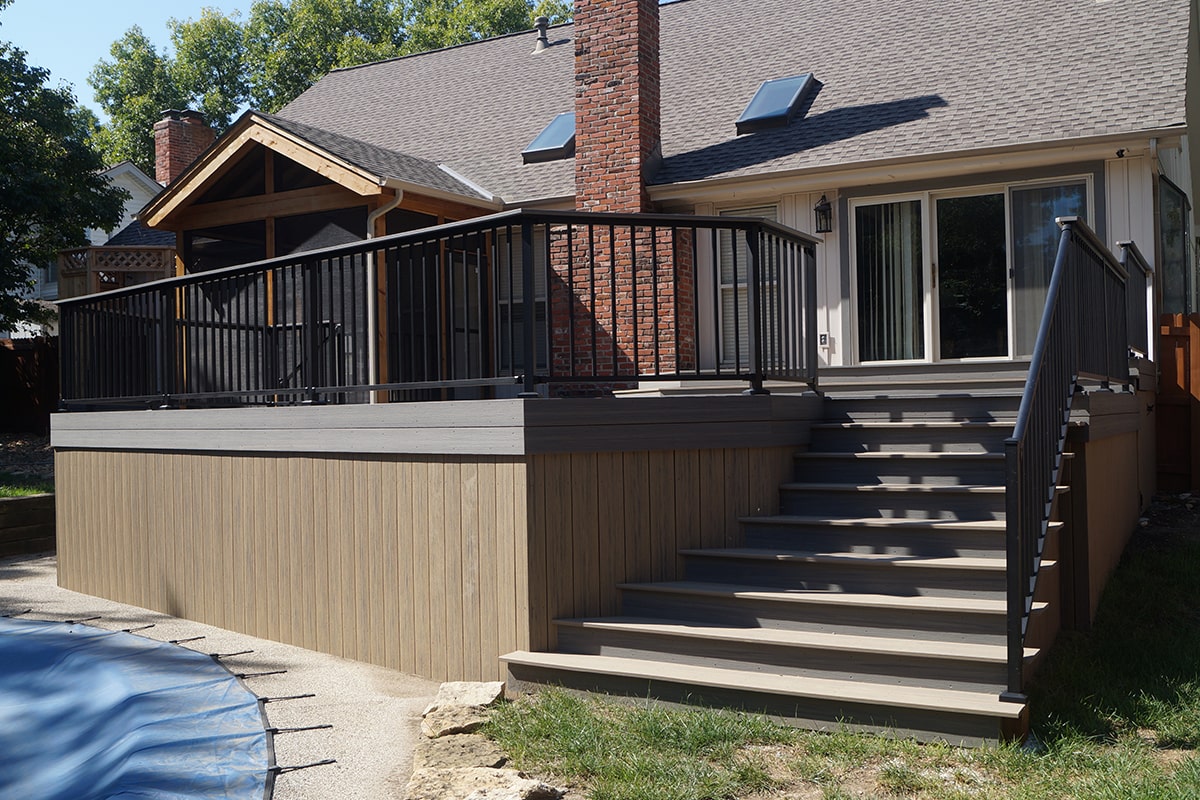Choosing the right material for your deck is a crucial decision that impacts not only the aesthetics of your outdoor space but also its durability, maintenance requirements, and overall cost. At DW Decks, we understand that homeowners often find themselves torn between traditional wood decking and modern composite decking. Let’s explore the differences between these two options to help you make an informed choice.
Composite Decking: What it is, Advantages, Disadvantages
Composite decking is an engineered product made from a blend of wood fibers and plastic materials. This combination results in a durable, low-maintenance decking option that has gained popularity over the years. The materials are combined and molded into boards that mimic the appearance of natural wood but come with enhanced resilience against the elements.
Advantages of Composite Decking
1. Low Maintenance
One of the standout benefits of composite decking is its minimal maintenance requirements. Unlike traditional wood, which needs regular sanding, staining, and sealing, composite decking requires only periodic cleaning with soap and water to maintain its appearance. This means more time enjoying your deck and less time maintaining it.
2. Durability and Longevity
Composite decking is designed to withstand various environmental challenges. It is resistant to:
- Moisture and Rot: The plastic components prevent water absorption, reducing the risk of rot and decay.
- Insect Damage: Unlike wood, composite materials aren’t susceptible to termites and other pests.
- Splintering: The surface remains smooth over time, eliminating the worry of painful splinters.
These features contribute to a longer lifespan, with many composite decks lasting 25 to 30 years or more.
3. Environmental Considerations
Many composite decking products are made from recycled materials, such as plastic bags and reclaimed wood fibers, making them an eco-friendly choice for environmentally conscious homeowners.
Disadvantages of Composite Decking
1. Higher Initial Cost
The upfront cost of composite decking is typically higher than that of traditional wood. However, when considering the reduced maintenance expenses and longer lifespan, many homeowners find that composite decking offers better value over time.
2. Temperature Sensitivity
Composite materials can become hot under direct sunlight, which might make them uncomfortable for bare feet during peak summer months.
Traditional Wood Decking: What it is, Advantages, Disadvantages
Traditional wood decking utilizes natural timber, such as pressure-treated pine, cedar, or tropical hardwoods like ipe. Wood has been a longstanding choice for decking due to its natural beauty and the classic aesthetic it provides.
Advantages of Traditional Wood Decking
1. Natural Aesthetics
Wood offers an authentic look and feel that many homeowners cherish. Each plank has unique grain patterns and colors, providing a warm and inviting atmosphere.
2. Lower Initial Cost
Generally, wood decking has a lower upfront cost compared to composite options, making it an attractive choice for budget-conscious projects.
3. Customization
Wood can be easily stained or painted to achieve a desired color or finish, allowing for greater customization to match your home’s exterior.
Disadvantages of Traditional Wood Decking
1. High Maintenance
Wood decks require regular upkeep, including cleaning, sanding, staining, and sealing, to protect against weathering, rot, and insect damage. Neglecting this maintenance can lead to a shorter lifespan and increased repair costs.
2. Susceptibility to Environmental Damage
Wood is prone to:
- Rot and Decay: Especially in moist or humid environments.
- Insect Infestation: Termites and other pests can cause significant structural damage.
- Splintering: Over time, wood can crack and splinter, posing safety hazards.
3. Variable Lifespan
The longevity of a wood deck heavily depends on the type of wood used and how well it’s maintained. While some hardwoods can last longer, softwoods may need replacement or significant repairs within 10 to 15 years.
Making the Right Choice for Your Home
When deciding between composite and traditional wood decking, consider the following factors:
1. Maintenance Commitment
If you prefer a low-maintenance option that saves time and effort, composite decking is the way to go. However, if you’re willing to invest time in regular upkeep to enjoy the natural beauty of wood, traditional decking might suit you better.
2. Budget Considerations
While wood decking has a lower initial cost, it’s essential to factor in the ongoing maintenance expenses. Composite decking’s higher upfront price can be offset by its durability and minimal maintenance requirements over time.
3. Environmental Impact
For those concerned about sustainability, composite decking made from recycled materials offers an eco-friendly alternative to traditional wood.
4. Climate and Environmental Conditions
Consider your local climate. In areas with high humidity, frequent rainfall, or termite activity, composite decking’s resistance to moisture and pests can be a significant advantage.
In Summary
Both composite and traditional wood decking have their unique benefits and drawbacks. At DW Decks, we believe in providing our clients with all the information necessary to make the best choice for their specific needs. If you’re looking for a durable, low-maintenance, and eco-friendly option, composite decking is an excellent choice. On the other hand, if you value natural aesthetics and don’t mind regular maintenance, traditional wood decking remains a timeless option.
For personalized advice and professional installation services, contact us today. Our team is ready to help you create the outdoor space of your dreams.







